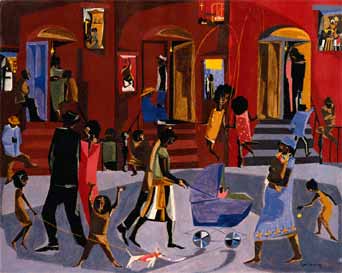|
|
 |
 |
 |

Brownstones, 1958. Egg tempera
on hardboard, 31 1/2 x 37 1/4 in. (80 x 94.9 cm). Collection of Clark
Atlanta University Art Galleries; gift of Chauncey and Catherine Waddell
© Clark Atlanta University Art Galleries
Artwork © Gwendolyn Knight Lawrence, courtesy of the Jacob and
Gwendolyn Lawrence Foundation
Click here to view a larger image |
| |
|
 |
 indicates a link to another site
indicates a link to another site
During the 1920s and 1930s, as a result of the combined forces of
the  Great
Migration, the Great
Migration, the  Depression,
the Depression,
the  Jazz
Age, and the Jazz
Age, and the  Harlem
Renaissance, Harlem blossomed into a community with a srtong and
unique identity. An enclave for African-American literary and visual
art, this new cultural arena enjoyed a sense of optimism in spite
of economic difficulties. Like many writers and artists of his time,
Jacob Lawrence was inspired by the dynamic vitality of the Harlem
community. Harlem
Renaissance, Harlem blossomed into a community with a srtong and
unique identity. An enclave for African-American literary and visual
art, this new cultural arena enjoyed a sense of optimism in spite
of economic difficulties. Like many writers and artists of his time,
Jacob Lawrence was inspired by the dynamic vitality of the Harlem
community.
In this image, Lawrence depicted a city street teeming with activity.
Lawrence used repetition and patterns to create the rhythm of this
city scene. Unlike earlier works, in which people and places are portrayed
in flat color, in this painting, Lawrence created depth through the
use of shadow.
A young boy walking a dog directs the viewer's attention to the center
of the image, where a couple pushes their baby carriage. Other couples
and paired figures appear throughout the image. In the center of the
painting, two young girls are poised in mid-air as they jump rope.
Figures in the background relax and engage in conversation on their
stoops. Lawrence also offered multiple views into the brownstone's
open windows. |
|
|

What makes a neighborhood?
How would you describe your neighborhood?
How is your neighborhood similar or different to this one?
• Observe and make sketches of a favorite place in your neighborhood
at a particular time of day. Include people, shadows, repeated shapes, and
patterns in your sketches. |









